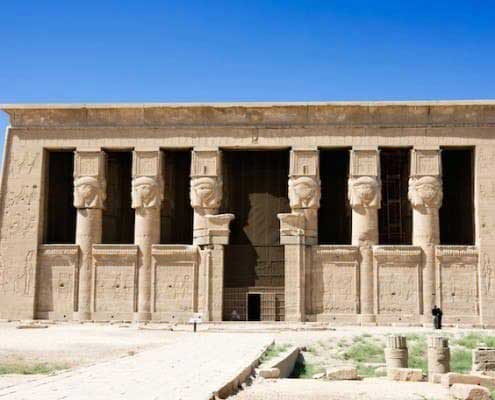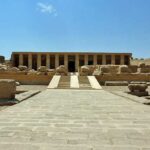The Temple of Dendara is one of the best-preserved temples in Egypt. It was known as the “Castle of the Sistrum” or “Pr Hathor”— House of Hathor.
The Temple of Hathor at Dendera is largely believed to be one of the best preserved temple of its kind in all of Egypt. It is a vast structure covers more than 40,000 square meters, and it stands directly above older buildings dating back to the time of the pyramids of Cheops and Khufu of the 4th dynasty.
Also at Dendera Temple, visitors can explore a small chapel dedicated to Isis, as well as the ruins of an old Coptic Church. There are also a number of Roman and Pharaonic birth houses. An interesting fact to think about when visiting the area, is that Cleopatra herself is said to have given birth to a son at the birth houses at Dendera Temple.
This article contains information about The Temple of Dendera complex including:
- Where is the Temple of Dendera located?
- Dendera city
- Visiting The Temple of Dendera
- How much does it cost to visit The Dendera temple?
- When was the temple of Hathor built?
- The layout and description of Hathor temple of Dendera
- Recommended Tours to The temple of Dendera
- Frequently asked questions about visiting Egypt
Where is the Dendera temple located?
The Temple is about 4km from the west bank of the Nile roughly opposite the city of Qena. The capital of the province and governorate of Qena (population – 2,000,000), is inhabited by both Coptic and Muslims. This town is famous for the manufacturing of water pots, called “gula” jars in Arabic.
The Muslim Sheik, Abdel Raheem El-Kenawi, spent all of his life in this town. His death, in 1170 A.D, founded the modern city, and his birthday is celebrated every year. A great number of pilgrims come from all over Egypt for the festivities. Qena’s name dates back to the time of the pharaohs, and was taken from the ancient Egyptian word Qeny, which means, “to bend”; the River Nile has a huge (and famous) bend here.
Dendera City
Dendera city is located on the west bank of the Nile, south of Abydos. Most of the monuments of Dendera city date back to the Ptolemaic and late Coptic periods with some relics goes back to the Egyptian new kingdom ,the most famous among them is Hathor temple or also known as Dendera temple complex which was constructed in the Greco Roman period and incorporates ruins of old and new kingdom. there are two Roman wells in front of the temple entrance and three parallel chapels to each other, the temple is well preserved and originally was a healing center dedicated to Hathor goddess of fertility and healing and the wife of god Horus. the most fascinating sight of the temple is the roof chapel dedicated to Osiris , the walls and the columns are covered by Roman emperors figures with Egyptian gods reliefs . Travel to Egypt company has already arranged Nile river cruise and Luxor day tours that include visits to Abydos and Dendera temples.
In ancient times, Dendara was associated with healing. Patients who traveled there for cures were housed in special buildings where they could rest, sleep, and commune with the gods in their dreams. There is something else special about this temple, as well: It bears the name of Cleopatra and her son, whose father was Julius Caesar. It is possible that these celebrated rulers climbed the same stairs and contemplated the same landscape stretching out for miles below.
Today, the place sings with the music of birds. Hundreds of them roost in small cracks and hollows in the walls, seemingly contemplating their own carved likenesses in the hieroglyphic reliefs.
There have been temples on this site ever since the Old Kingdom, but the present temple was begun in the reign of Ptolemy VIII. The building we see today was constructed and added to from about 116 BC to 34 AD.
Hathor was the goddess of love, joy, and beauty. With the exception of its supporting pillars, which had capitals sculpted in the image of Hathor and were defaced by the Christians, the walls, rooms, and roof are complete and extraordinarily well preserved. The stone steps of the spiral staircase are time worn but may still be used to ascend to the roof, where there is a small chapel decorated with Hathor-headed columns.
Visiting the Temple of Dendera
Visitors to Luxor should try to visit the famous Temple of Hathor at Dendera if they have the chance. By taxi, the trip takes about 1 hour, from Luxor. The buses, which are always accompanied by a police convoy, leave at8 AM daily. The entrance fee is LE 100.
Due to its location, the Dendera Temple is typically only visited by tourists traveling to or from Luxor. It is also quite often included in Nile cruises from Luxor to Aswan that feature a visit to Luxor. Likewise, most Nile cruises from Aswan to Luxor will include a visit to this remarkably well preserved attraction.
If you’re traveling on your own it can be a little bit tricky get to the site, and it should be noted that some budget tours rely on the use of tour coaches. If however you are booking your Egypt all-inclusive vacation through us and it includes a trip to Dendera Temple, you’ll typically be driven to the site in an air conditioned vehicle by your personal guide and driver.

How much does it cost to visit the Temple of Dendera?
Tickets, which cost 100 Egyptian pounds (approximately $6) for adults and 50Egyptian pounds (or $3) for students, can be purchased at the entrance’s visitors center.
When was the temple of Hathor built?
The Temple of Hathor was built in the 1st century B.C by Ptolemy VIII and Queen Cleopatra II, and it’s is one of the best-preserved Temples in all of Egypt! Later, Roman Emperors continued to decorate it to honor the Hathor, the goddess of maternity, love, and music. The Greeks knew Hathor as Aphrodite.
The layout and description of Hathor temple of Dendera
The first gateway, built by Roman Emperor Domitian in 80 A.D, leads to the well-preserved great hall, which is decorated with Hathoric columns (columns with the face of Hathor on them). The upper, front edge of the cornice is decorated with the winged sun disc, while stone screens between the columns and the scene representing the Roman Emperor Tiberius and other Roman rulers who present votive offerings to the Goddess of the Temple, enclose the front portion. Hathor is mainly represented, with the horns of the sacred cow protruding from her head, supporting the solar disc of the sun. In her hands she holds an “Ankh” (the symbol of life), and a scepter.
The interior walls of the great hall have remarkable scenes depicting sacrifices made to the goddess of the temple. The amazing ceiling abounds with astronomical representations!
The ceiling is divided into 7 ways, and the best remaining 3 are:
- The first division on the eastern side, which depicts the Nut, the goddess of the Sky, who is bending herself towards the earth, with the sun disc shining on the temple and the mask of Hathor.
- Secondly, and next to the first, is a representation of the sun boat and star goddess.
- The third one is the western ceiling, which shows a perfect representation of the zodiac signs, one of the reasons that the temple is so beloved (the original zodiac relief is now in the Louvre museum in Paris, France). The 12 figures are the ram, the bull, the heavenly twins, the crab, the lion, the virgin, the scales, the scorpion, the archer, the goat, the watering pots and fishes with glittering tails. On the inner walls of the screen, the hawk-headed god Horus, and the Ibis-headed god Thoth, are pouring drops of holy water over the king. This scene is called the baptism scene, symbolizing life and happiness.
The second hall has 6 columns adorned with rich capitals and granite pedestals. On both sides of this hall are small storerooms, used to store the wine jars that came from the Island of Crete, and the fertile Fayoum and Kharga oases.
Next is the central chapel and its two altars; one for the sacred boat and the other for the sacrifices offered to the Goddess Hathor. The beautifully sculptured reliefs on the walls of the shrines represent Ptolemy VIII and other rulers, whose names were left blank in the oval cartouches, dancing with offerings to the sacred boat of Hathor and her husband Horus. The representatives of the king, the high priests, and some noblemen, once gathered in the great hall to prepare for the daily rituals. The ceilings are covered in stars and black soot from the fires caused by later inhabitants of the Temple. The rooms around the sanctuary were used for scientific purposes, as well as the storing of the sacred boat, the sacred wreath, the golden image of the Goddess Hathor and musical instruments.
There is a small corridor on the right, which leads to a small room that contains the crypt, a great spot to visit. The staircases, which lead to the roof of the temple, are decorated with beautiful symbols of the 12 months of the year. On the eastern corner, of the roof, is the chapel of the god Osiris. The scenes on its walls represent Osiris rising from the dead and becoming the god of the underworld. It is from this chapel that the best representation of the zodiac was taken.










